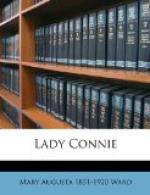“There are, of course, your own expectations from Lord Dagnall. I do not know whether you and your father have considered them. But I imagine it would be possible to raise money on them.”
Falloden laughed. The sound was a mixture of irritation and contempt.
“Uncommonly little! The fact is my uncle—at seventy-two—is philandering with a lady-housekeeper he set up a year ago. She seems to be bent on netting him, and my father thinks she’ll do it. If she does, my uncle will probably find himself with an heir of his own. Anyway the value of my prospects is enormously less than it was. All the neighbours are perfectly aware of what is going on. Oh, I suppose he’ll leave me something—enough to keep me out of the workhouse. But there’s nothing to be got out of it now.”
There was another silence. Falloden pondered the figures before him.
“There are always the pictures,” he said at last, looking up.
The lawyer’s face lightened.
“If you and Sir Arthur will sell! But as you know they are heirlooms, and you could stop it.”
“On the contrary, I am ready to agree to it,” said Falloden briefly. “But there will be a lot of legal business, won’t there?”
“Certainly. But it can all be put through in time. And directly it was known that you would sell, the whole situation would be changed.”
“We might save something out of the wreck?” said Falloden, looking up.
The lawyer nodded gravely.
“Something—certainly.”
“What are they worth?” said Falloden, taking a note-book from his pocket, and looking at a list scribbled on its first page.
Mr. Gregory laughed.
“There is no market in the ordinary sense for such pictures as yours. There are only half a dozen millionaires in the world who could buy them—and one or two museums.” He paused a moment, looking thoughtfully at the young man before him. “There happens, however,”—he spoke slowly—“to be a buyer at this moment in London, whom it would be difficult to beat—in the matter of millions.”
He mentioned the name.
“Not an American? Well, send him along.” Falloden raised his eyebrows. “If my father doesn’t feel able to see him, I can tackle him. He can choose his own day and hour. All our best pictures are at Flood.”
“And they include—”
“Four Rembrandts,” said Falloden, looking at his list, “two Titians, two Terburgs, a Vermeer of Delft, heaps of other Dutchmen—four full-length Gainsboroughs, and three half-lengths—two full-length Reynoldses, three smaller—three Lawrences, a splendid Romney, three Hoppners, two Constables, etc. The foreign pictures were bought by my grandfather from one of the Orleans collections about 1830. The English pictures—the portraits—have all been at Flood since they were painted, and very few of them have ever been exhibited. I scribbled these few facts down before I left home. There is, of course, an elaborate catalogue.”




